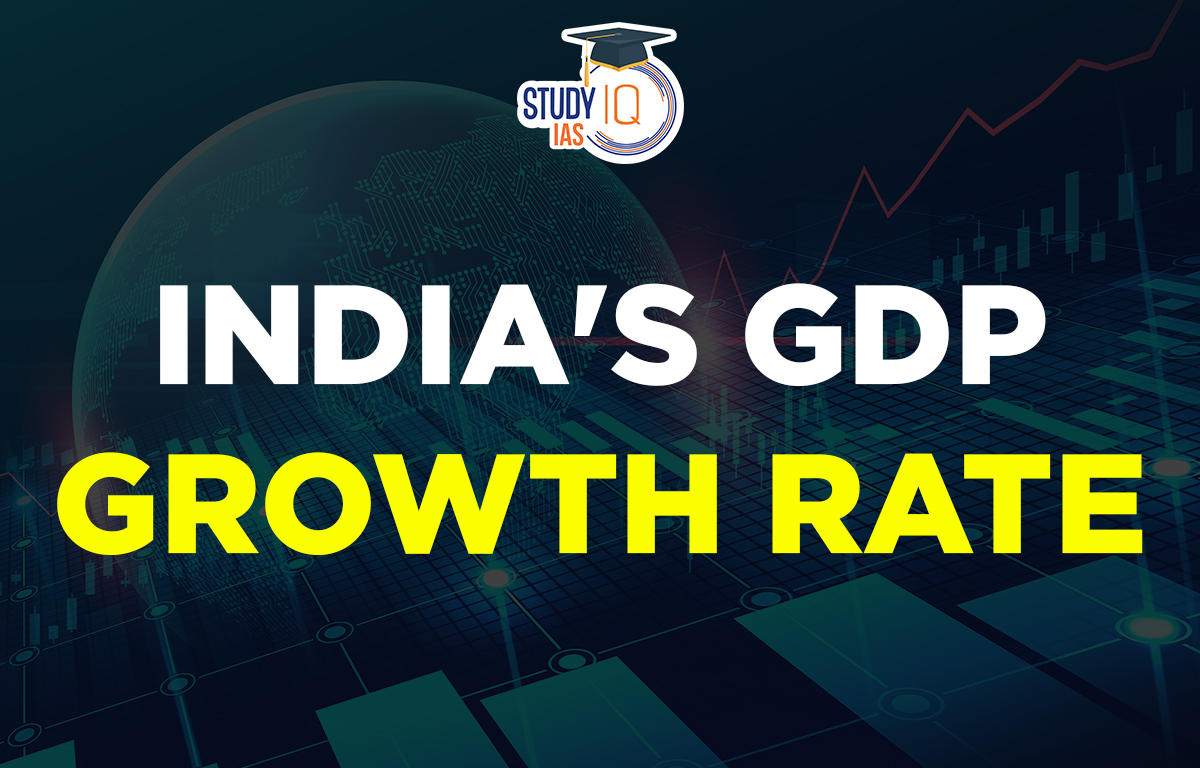Table of Contents
India’s GDP Growth Rate
India’s GDP Growth Rate fell to 4.4% in the third quarter. In Q3, the gross value added (GVA) increased by 4.6%. The GDP is the indicator of the size of the domestic economy. The full form of GDP is Gross Domestic Product. GDP is essentially the total of the final prices of the products and services produced in an economy over a specific time period. It is reviewed frequently to take into account shifting production structures, comparable prices, and improved economic activity recording. Since India’s GDP growth rate is a subject that frequently makes the news, it is pertinent to the UPSC Mains.
GDP of India
GDP is the total monetary or market value of all finished goods and services produced within a country’s borders in a given time period. It serves as a comprehensive scorecard of a country’s economic health because it is a broad measure of overall domestic production. The government changed the base year for national accounts in January 2015 from the previous base year of 2004-05 to the new base year of 2011-12 and national accounting’s base year had already undergone revision in January 2010.
The Gross Domestic Product (GDP) at factor cost was abandoned in favour of the gross value added (GVA) at basic prices adopted by other countries in the new series by the Central Statistical Office (CSO).
India’s GDP Growth Rate of the economy for 2013–14 was expected to be 6.9% on the basis of the new base year; it was 4.7% on the basis of the 2004–05 base. Similar to this, the GDP growth rate for 2012–13 increased from 4.5% to 5.1%.
GDP Growth Rate in Third Quarter of Current Fiscal Year 2022–23
The Ministry of Statistics and Programme Implementation recently released data showing that the third quarter of the current fiscal year 2022–23 witnessed GDP expand at a pace of 4.4%. The growth rate was 6.3% in the first quarter of the current year and fell to 4.4% in the third quarter. In Q3, the gross value added (GVA) increased by 4.6%.
The results show that the agricultural sector, which increased from 2.4% in Q2 to 3.7% in Q3, had the strongest performance during the previous three quarters. A downturn in the manufacturing sector, reduced demand, and low government spending were the main causes of the decline.
The National Statistical Office (NSO), Ministry of Statistics, and Programme Implementation publish quarterly GDP data. According to the government, in the fiscal year 2022–2023, the economy will grow at a 7% annual pace. According to experts, the economy is under threat from factors such as El Nino, rising prices, sluggish demand, and slow global growth.
GDP Growth Rate of India in 2022-2023
The Economic Survey 2022-23 projects a baseline GDP growth rate of 6.5 per cent in real terms in FY24. The projection is broadly comparable to the estimates provided by multilateral agencies such as the World Bank, the IMF, and the ADB and by RBI, domestically.
India’s economy is to grow 6.0-6.8% in 2023-24, compared to 7% in 2022-2023 and 8.7% in 2021-22. Gross domestic product (GDP) in nominal terms is to be 11% in the next fiscal. GDP Growth rates are driven by private consumption, higher capex, strengthening the corporate balance sheet, credit growth to small businesses and return of migrant workers to cities.


India’s GDP Growth Rate Chart
Since the turn of the century, India’s annual GDP growth rate has averaged 6% to 7%. For most of recorded history, up until the early 19th century, the Indian subcontinent’s economy was the largest in the world. In 2022, India accounted for 7.2% of the global economy in PPP terms, and around 3.4% in nominal terms. The graph below shows the various trends in India’s GDP Growth Rate from 2009-2023

India’s GDP Growth Rate Last 10 years
India’s GDP Growth rate in the last 10 years has been at an average Growth rate of 6-7 per cent. From 2006 to 2023, India averaged 6.15 per cent, with a high of 8.7 per cent in 2022 and a low of -6.6 per cent in 2021.
India surpassed the United Kingdom to become the world’s fifth-largest economy. The only countries with economies larger than India’s are the United States, China, Japan, and Germany. In an uncertain world, real GDP growth of 6-6.5% is the new normal, and India is on track to become the third-largest economy by 2029.
The table below shows India’s GDP growth rate over the last 10 years as per the Economic Survey:
| Year | GDP Growth Rate |
| 2014-15 | 8.0 |
| 2015-16 | 8.2 |
| 2016-17 | 7.2 |
| 2017-18 | 7.1 |
| 2018-19 | 4.5 |
| 2019-20 | 3.7 |
| 2020-21 | -6.6 |
| 2021-22 | 8.7 |
| 2022-23 | 7.0 |
| 2023-24 | 6.0-6.8 |
It’s important to note that the GDP Growth rate estimates for 2023-24 are subject to change as data becomes available, and the policies have had a significant impact on the Indian economy. However, the estimates suggest India’s economy is expected to rebound strongly in the fiscal year of 2023-24.
























 WhatsApp
WhatsApp